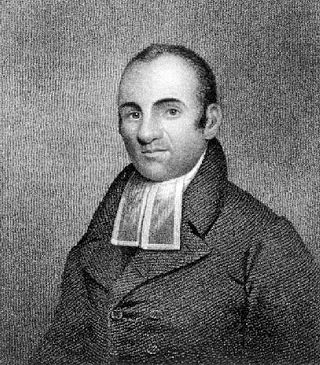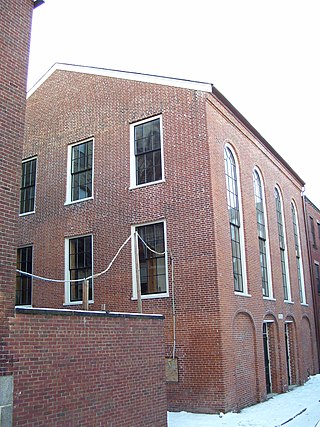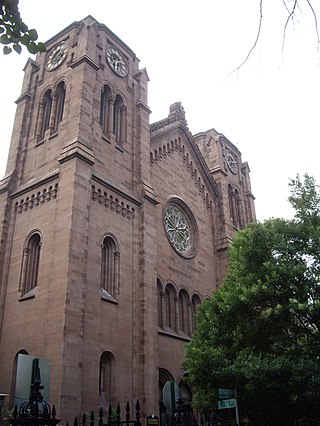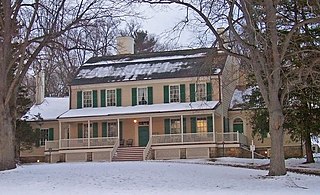
Granville is a town on the eastern border of Washington County, New York, United States, abutting Rutland County, Vermont. It is part of the Glens Falls Metropolitan Statistical Area. The town population was 6,215 at the 2020 census.

Lemuel Haynes was an American clergyman. A veteran of the American Revolution, Haynes was the first black man in the United States to be ordained as a minister.

The African Meeting House, also known variously as First African Baptist Church, First Independent Baptist Church and the Belknap Street Church, was built in 1806 and is now the oldest black church edifice still standing in the United States. It is located in the Beacon Hill neighborhood of Boston, Massachusetts, adjacent to the Black American Abiel Smith School. It is a National Historic Landmark.

List of the National Register of Historic Places listings in Washington County, New York

St. George's Episcopal Church is a historic church located at 209 East 16th Street at Rutherford Place, on Stuyvesant Square in Manhattan, New York City. Called "one of the first and most significant examples of Early Romanesque Revival church architecture in America", the church exterior was designed by Charles Otto Blesch and the interior by Leopold Eidlitz. It is one of the two sanctuaries of the Calvary-St. George's Parish.

The Duke Ellington House is a historic residence at 935 St. Nicholas Avenue, in Manhattan, New York City. Apartment 4A in this apartment house was the home of Duke Ellington (1899-1974), the noted African American composer and jazz pianist, from 1939 through 1961. It was listed on the National Register of Historic Places as a National Historic Landmark in 1976.
Minard Lafever (1798–1854) was an American architect of churches and houses in the United States in the early nineteenth century.

The John Jay Homestead State Historic Site is located at 400 Jay Street in Katonah, New York. The site preserves the 1787 home of Founding Father and statesman John Jay (1745–1829), one of the three authors of The Federalist Papers and the first Chief Justice of the United States. The property was designated a National Historic Landmark in 1981 for its association with Jay. The house is open year-round for tours.

The Prudence Crandall Museum is a historic house museum, sometimes called the Elisha Payne House for its previous owner. It is located on the southwest corner of the junction of Connecticut Routes 14 and 169, on the Canterbury, Connecticut village green. It is designated a U.S. National Historic Landmark as Prudence Crandall House.

The Commercial Bank and Banker's House is an unusual combination building, housing both a bank premises and the principal banker's residence, at 206 Main Street and 107 Canal Street in Natchez, Mississippi. Built-in 1833, it is a remarkably high-quality and well-preserved example of Greek Revival architecture. It was designated a National Historic Landmark in 1974. The bank portion of the building, used for a time by a Christian Science congregation, is presently vacant, while the house portion is a private residence. Both the buildings have carved limestone used extensively, columns lintels, window sills, and the entire facia are all carved limestone with the walls being 20" thick brick construction with scored plaster to have the appearance of large limestone blocks.

The John Paul Jones House is a historic house at 43 Middle Street in Portsmouth, New Hampshire. Now a historic house museum and a National Historic Landmark, it is where American Revolutionary War naval hero John Paul Jones, resided from 1781-82 when it was operated as a boarding house. He also lived in a home in Fredericksburg, Virginia, on Caroline Street, owned by his brother.

Bethesda Presbyterian Church is a historic church at 502 DeKalb Street in Camden, South Carolina. A National Historic Landmark, the main church building was built in 1822 and is one of few surviving churches designed by 19th-century American architect Robert Mills.

The Robert Smalls House is a historic house at 511 Prince Street in Beaufort, South Carolina. Built in 1843 and altered several times, the house was designated a National Historic Landmark in 1974 for its association with Robert Smalls (1839-1915). Smalls, born into slavery, achieved notice for commandeering the CSS Planter and sailing her to freedom during the American Civil War. After the war he represented South Carolina in the United States House of Representatives during Reconstruction.

The Old Marine Hospital is a historic medical building at 20 Franklin Street in Charleston, South Carolina. Built 1831–33 to a design by Robert Mills, it was designated a National Historic Landmark in 1973 for its association with Mills, and as a high-quality example of Gothic Revival architecture. The hospital was built as a public facility for the treatment of sick sailors and other transient persons.

The South Granville Congregational Church is located on NY 149 in the hamlet of South Granville, in the town of Granville, New York, United States. The current church building is the fourth in the church's history. It is a white frame church built in the 1840s; nearby is a Greek Revival parsonage of similar vintage. The church was extensively renovated and expanded in 1873, giving it more of a Late Gothic Revival appearance.

St. Joseph Roman Catholic Church and Rectory was a historic Roman Catholic church and rectory located at 108 Franklin Street, Rochester in Monroe County, New York. The complex was listed on the National Register of Historic Places in 1975. The structure's shell has been preserved as monument after a disastrous fire.

The Georgia Plain Baptist Church is a historic church in Georgia, Vermont. Built in 1877 for a congregation established in 1793, it is a well-preserved example of High Gothic Victorian architecture. It was listed on the National Register of Historic Places in 2001. The congregation is affiliated with the American Baptist Churches of Vermont and New Hampshire.

St. James Church is a historic Episcopal church building at 86-02 Broadway in the Elmhurst neighborhood of Queens in New York City. It is the city's oldest surviving Anglican building and Church of England mission church. It is also alternatively called the Old St. James Church to distinguish it from the St. James Episcopal Church two blocks away.
Town–Hollister Farm is a historic home and farm complex located on the western side of the hamlet of North Granville in Washington County, New York. The property is of both historical and architectural significance. The farm encompassing 275 acres includes a Federal-style farmhouse built around 1810 and multiple 19th and 20th-century agricultural-related structures which illustrate the agricultural activities of the farm and offer information on the vernacular design and timber framing practices of the region. The property was recommended to the New York State and National Historic Registries in 2007 and listed on the National Register of Historic Places in 2008.





















